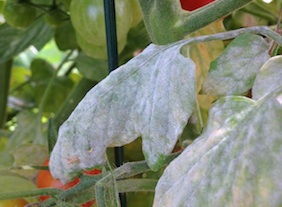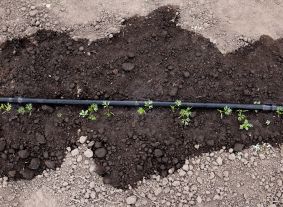Powdery Mildew on Cucurbits
Views: 3373

Dont let the fancy word cucurbits scare you off. In fact, you probably have a cucurbit or two in your own garden. This fun-sounding word refers to plants in the Cucurbitaceae family, and you can probably guess by now that this includes cucumbers, as well as other veggies like zucchini, squashes, melons, and gourds. And luffa, too, as a quick fun fact. Cucurbits may be a varied group of veggies, but around this time of year they all have something in common: powdery mildew.
Powdery Mildew
Powdery mildew is a fungal disease that appears first as small, circular, white spots on the cucurbits large green leaves. It may look like early-morning dew at first, given the time of day and all. But on a dry leaf, the white spots are easy to see.
The spots typically appear on the plant’s lower (also older) leaves, and the individual spots will gradually merge together to cover the entire leaf. As this happens over a period of days, the leaf will become lighter green and then yellowish, and then crispy brown around the edges, until the leaf is dead. And by that time, the powdery mildew has passed the torch, so to speak, to the next leaf, and the next, and the next. Thanks to it being a fungus, those fungal spores do get around quite easily. The sporey whitishness even travels down the stem.
Stopping the Spread
Last year I had a pretty good plan for dealing with powdery mildew on my zucchini. I removed each infected leaf as the tell-tale white spots appeared. How can stripping a plants leaves be good for it?
Thankfully, as you know, zucchini grows at a lightning pace. New leaves are unfolding on an ongoing basis. As I yank them off, new leaves take their place. What I end up with is a plant with a long central stem (or two) that acts as an umbilical cord for the leaves and developing fruit at its tip, which, as the season nears its end, can be a good 5 feet away.
I try to be as careful as possible when removing the infected leaves, in order to minimize the spread of the spores.
Here are step-by-step instructions for stopping the spread of powdery mildew:
1) Remove the leaf when the white spots are still small and the spores have not yet appeared on the stem
2) Grab the leaf by the stem to minimize spores on your gloves
3) Move the leaf SLOWLY
4) Immediately place the leaf into a trash bag
There are homemade solutions I’ve found online that are said to slow and/or stop powdery mildew, but I’ve seen shaky and inconsistent results from those. Several friends have recommended a product (approved for organic gardening) called Milstop, and I’ll give that a go in the coming days.
But really, who are we kidding? Homemade and commercial products may slow the spread, but nothing really stops powdery mildew. Think of it as part of your cucurbits’ natural life cycle. That will at least ease your frustrations.
Meet Ellen Wells
When you’re raised on a farm, you can’t help but know a thing or two about gardening. Ellen Wells is our expert on edible gardening.…
Ellen's Recent Posts

Asparagus






